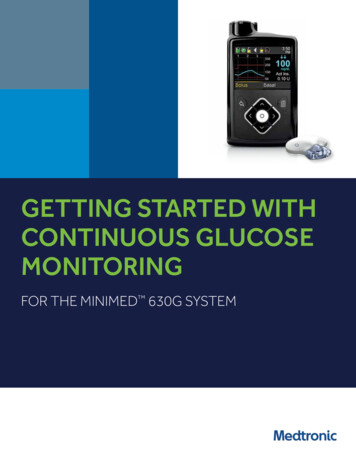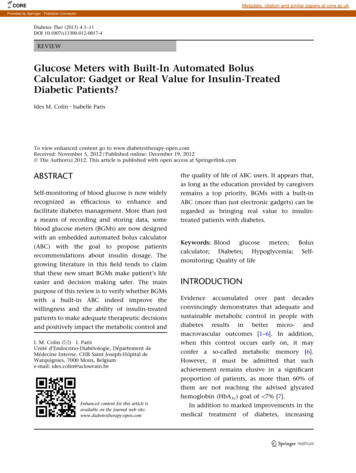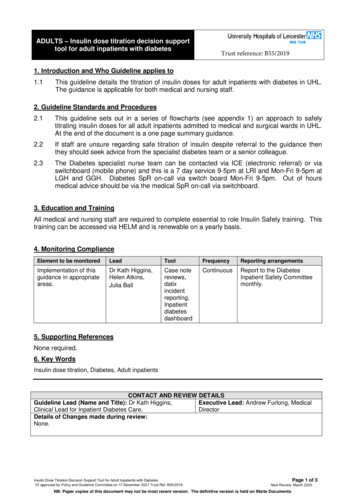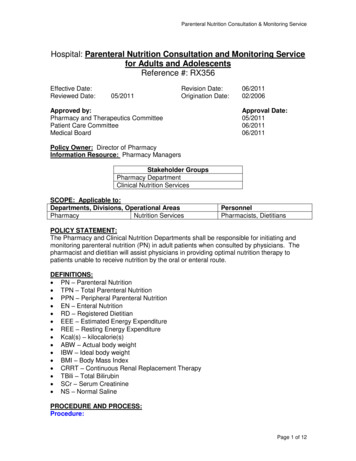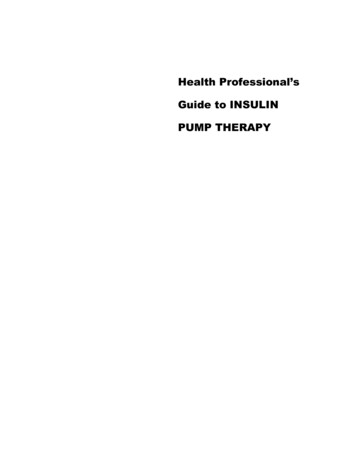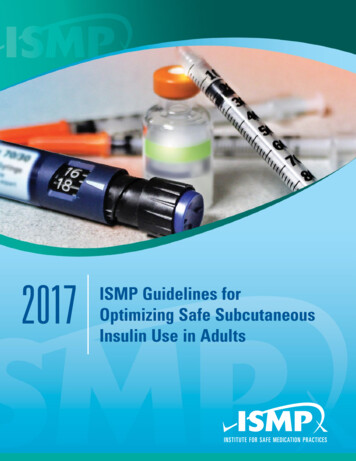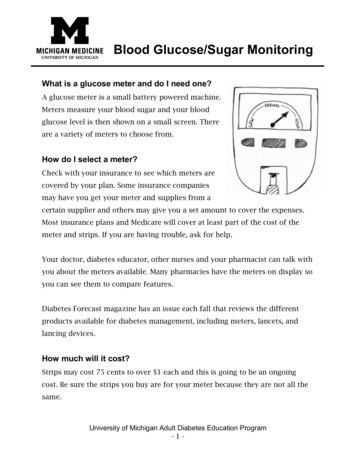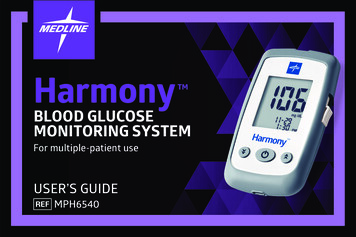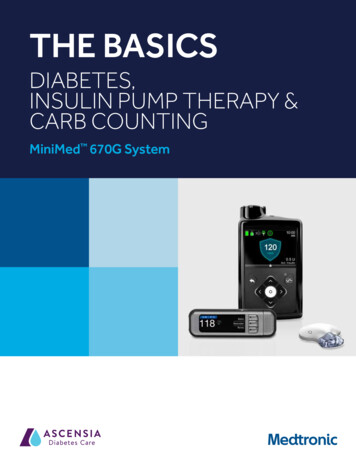
Transcription
Insulin Pumps andContinuous Glucose MonitoringParis Roach MDAssociate Professor of Clinical MedicineDivision of Endocrinology and MetabolismIndiana University School of Medicine
DisclosuresI have no conflicts of interest, financial or otherwise, with thecommercial concerns that will be mentioned in this presentation.Because there are very few manufacturers of insulin pumps and CGMdevices, and because no such generic products are available, tradenames will be mentioned during this presentation for clarity and inorder to increase the quality of the presentation.Every effort will be made to present commercial products in a nonbiased fashion.
Insulin Pump vs Insulin Injections More predictable insulin absorptionand precise delivery Programmable insulin delivery allowsclosest match with physiologic insulinrequirements
Physiologic insulin secretion75Insulin5025Basal insulin0150Glucose10050Basal glucose07 8 9 10 11 12 1 2 3 4 5 6 7 8 9a.m.Time of Dayp.m.
Insulin ActivityIdealized Basal Insulin ReplacementNPHGlargineB’fast LunchDinnerBed OvernightB
Basal insulin requirements are variable!Decreasinginsulin onBed Overnight
Meal Bolus: Square Wave FunctionStandard BolusSquare waveBasal rate
Who Needs an Insulin Pump? Sensitive to small changes in insulin levels inbasal insulin supply Sensitive to changes in physical activity –increased risk of hypoglycemia Day to day activities vary Excellent self-mgmt skills, realistic expectations
Precise Delivery Patient Data
Matching Physiologic Needs Patient Data
Interstitial Fluid Glucose Measurement
CGM: Snapshot vs. ContinuousGlucose Sensor Profile: 12-18-99400350288 readings/24 hoursGlucose Concentration (m g/dL)300250Meter ValueSensor Value200InsulinMeal150ExerciseOther100500-5012:00 AM4:00 AM8:00 AM12:00 PMTime4:00 PM8:00 PM12:00 AM
CGM: Dexcom G5
Freestyle Libre CGM
Pump-CGM systemsMedtronic670GAccu-ChekSpiritTandem t:slimX2
The Dexcom G5 and FreeStyle Libreare “non-adjunctive”Patients can make treatment decisions, includinginsulin dosing, directly from the CGM data without theneed for confirmatory fingerstick testingThe Medtronic Guardian Sensor 3 does not yet havethis claim, so fingerstick glucose readings are requiredboth for calibration and insulin dosing.The Libre, also has a non-adjunctive indication,although fingerstick glucose levels are required toconfirm hypoglycemia or impending hypoglycemiabecause the system does not alarm for hypoglycemia.
Infusion Sites Infusion set: cannula, tubingand insulin reservoir. Usually placed in theabdomen, thigh, buttock. Changed every 72 hours. Several types available.
For more information on pumps, CGM:
Initiating Pump Therapy70-75% of Pre-pumpbasal dose 24Bolus dose based oninsulin to carb ratio(e.g. 1U/15g)
Mealtime dosing considerationsCarb content of mealCurrent blood glucoseCarb content of mealUse Insulin to Carb Ratio (1U:12g)Pre-meal blood glucose – use Target and ISF1800 Total Daily Dose (60) 1U lowers BG 30For 60g CHO meal with BG 180: 5U for CHO(180-120) 30 2 units for correction 7U
Fine Tuning: Basal Rate Monitor BG pre-meal, post-meal, bedtime, 3 am Adjust nighttime basal based on 3 am and prebreakfast BG; may need coverage for dawnphenomenon Adjust daytime basal based on pre-meal BG(after correcting postprandial hyperglycemia) Adjust basal by 0.1 u/hr or less to avoidover-correction Start higher rate 2 hours before glucosebecomes elevated
Fine Tuning: Bolus Doses Individualized insulin to carbohydrate ratio Adjust bolus based on 2 hour post-meal BGs Can use different ICRs for different meals Correction doses use ISF and BG targets. Avoid insulin “stacking” by setting“activeinsulin time” at 3-4 hours (5-6 for regular) Full coverage for frequent carb intake
Preventing DKA During Pump Use Monitor BG every 6 hours. Change infusion set every 2-3 days. Treat “incidental hyperglycemia” per algorithm. DO NOT go to bed or anywhere else with a highBG without confirming that it’s coming down.
Pump Stoppage in Type 1 DM N 7 type 1, pump discontinued at time 0 Mean plasma glucose increased 200 mg/dLfrom baseline at 7 hours (some sources sayBG increases by 50 mg/dL per hour) Mean capillary pH fell from 7.40 to 7.34 at7 hoursReichel et al., Exp Clin Endocrinol Diabetes 106 :186-172, 1998
Hyperglycemia Treatment Guidelines1st BG over 250 mg/dl: Take correction bolus via pump, check BG in 1 hour2nd BG over 250 mg/dl: Take correction bolus by syringe and changeinfusion set, check BG and ketones again in 1 hour Check urine ketones Call physician immediately if nausea and vomitingare present or if hyperglycemia, ketonuria persist “Twice in doubt, take it out.”
Exercise and the Pump Insulin levels fall during exercise to permit hepaticglucose production. In diabetes, exercise usually lowers glucose, but briefintense exercise can raise glucose. Suspend pump for activities lasting less than 1 hour. Use temporary basal for prolonged activity; start 50%. Carb intake is required for prolonged activity inaddition to reduced pump rate. May need prolonged reduction in basal rates andeven bolus after long-duration exercise
Insulin pump adjustments for physical activitySuspend for short duration ( 1h)activity (30-min run)Temp Basal for longduration (home project)B’fastLunchDinnerBed Overnight
Combined Insulin Pump-CGM Sensor Augmented insulin pump –CSII in conjunctionwith CGM Bihormonal, closed-loop system – uses twocommercially available pumps, with one deliveringinsulin and the other glucagon. Insulin-only, hybrid closed-loop system –uses onepump to deliver insulin. A hybrid system (not fullyautomated), in that only the basal insulin isautomatically adjusted based on CGM results. Usersneed to use conventional bolus calculations to doseinsulin prior to meals.
HOW DOES THE SUSPEND BEFORE LOW FEATURE WORK?Suspend before low suspends insulin delivery beforeglucose levels reach a pre-set low, without alerting the user.Suspends insulin delivery when glucose is within 70 mg/dL above the low limit and predicted to reachwithin 20 mg/dL above the low limit in 30 minutes. Automatically resumes when glucose reaches 20mg/dL above the low limit and predicted to reach 40 mg/dL above the low limit in 30 minutes and hasbeen suspended for 30 minutes.
Each patient’s daily insulin requirements are unique4 NIGHTS IN A SINGLE WEEK OF A PATIENTAuto BasalAuto BasalData on file, MedtronicAuto BasalAuto Basal
Each patient’s daily insulin requirements are uniqueTHERE IS SIGNIFICANT INTRA-PATIENT VARIABILITYAuto BasalAuto BasalData on file, MedtronicAuto BasalAuto Basal
Automated basal delivery compensates forunder or overestimates in carb intake1. Good overnightcontrol3. Under-estimatescarb intake2. Accurately countscarb intake4. Over-estimatescarb intake200160Fixed SGTarget 12080mg/dL4012a6aMax basal rateBasal(U/hr)Basal stops & resumes automatically12p6p12a
Pivotal trial for the Minimed 670G System Non-Randomized study designStudy DesignPatients Multicenter: 9 sites in US & 1site in Israel Single-arm (no control group) Non-randomized N 124 Type 1 2 years A1C 10% Ages 14-75 yr Pump therapy 6 months, with orwithout CGMStudy ProtocolRUN-IN PERIODPump CGM2 weeks1BergenstalSTUDY PERIOD: Auto Mode3 monthsR, et al. Poster presented at the 76th Scientific Sessions of the American DiabetesAssociation, June 10-14, 2016, New Orleans. LA. P-99. Bergenstal R, et al, JAMA. ePub ahead ofprint, September 15, 2016. doi:10.1001/jama.2016.11708
Medtronic 670G Pivotal Trial Results A1C fell by 0.5% run-in versus study period Time spent in range 24h: 72.2% vs 66.7% study vs run-inNocturnal: 75.3% vs 66.8 No DKA or severe hypoBergenstal R, et al. Poster presented at the 76th Scientific Sessions ofthe American Diabetes Association, June 10-14, 2016,New Orleans. LA. P-99.Bergenstal R, et al, JAMA. 2016;316(13): 1407-1408.
My 670G patient
Summary Pump therapy, CGM, and pump-CGM therapy facilitatethe treatment of type 1 diabetes and can improveglycemic control and reduce hypoglycemia. New automated closed-loop systems promise bettercontrol with less “mental burden”. Simpler and less costly CGM systems may broaden theutility of CGM to those with type 2 diabetes.
Associate Professor of Clinical Medicine Division of Endocrinology and Metabolism Indiana University School of Medicine. Disclosures I have no conflicts of interest, financial or otherwise, with the . 72.2% vs 66.7% study vs run-in Nocturnal: 75.3% vs 66.8 No DKA or severe hypo. Bergenstal R, et al. Poster presented at the 76. th.
